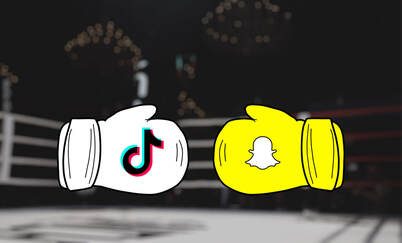Will TikTok overtake Snapchat?After the discontinuation of Vine, Snapchat took centre stage as the leading social platform for sharing short videos. Within months of Twitter shutting down Vine, however, TikTok – a video-sharing platform arriving as a result of a merger with Musical.ly - was founded and began to quickly rise in popularity. For marketers and influencers, it’s important to predict – as much as possible – which communication channels and social platforms have a future and are therefore worth their time and effort. Given how quickly TikTok became popular – with 800 million active monthly users – many are wondering whether Snapchat be overtaken by the newcomer. Target audience and functionality On a superficial level, the two platforms share both most of their basic functions and a target audience. Both Snapchat and TikTok are video-based platforms at their core, allowing for the sharing of short clips between friends and broader audiences. Both are popular especially with younger generations: 90% of Snapchat users and 69% of TikTok users are aged 13 to 24. Although it may seem as if Snapchat and TikTok are therefore the same service aimed at the same crowd, a closer analysis will show that they are in fact very different from each other in practice. Snapchat’s functionality is based on sharing videos for a limited time: they expire either immediately upon viewing or within a 24-hour period. TikTok, meanwhile, allows users to create videos that are available indefinitely on their profile and can be viewed like a gallery or a portfolio at any time. The two platforms therefore offer very different kinds of entertainment value to users. On Snapchat, content has a quality of being unique – it’s worth following someone to make sure you don’t miss your one and only opportunity to see a new piece of content. On TikTok, content is searchable and functions in a way similar to YouTube, allowing users to replay and share their favourite content. Content type Although both platforms are primarily video-based (Snapchat allows images, too), there is a marked difference in the type of content the userbases of each prefer. In general, Snapchat content tends to be more personal – to make sense of the short-lived videos, users usually need to follow the creator for a while or be aware of their branding from engagement on other platforms. Because Snapchat videos typically disappear upon viewing, creators can also get away with more controversial videos. TikTok content, meanwhile, is geared more towards universal entertainment value. The primary purpose of most popular profiles is not so much to build lasting connections and a dedicated group of followers, but to entertain as broad an audience as possible. The platforms as marketing tools Marketers looking to advertise on Snapchat or TikTok will quickly discover that here, too, the similarities between the platforms are mostly superficial. On Snapchat, brands can purchase ads – in a way vaguely similar to Facebook advertising. Branded content is displayed on the ‘Discover’ panel of the app, and includes a visual story about the brand or the product composed of a short video or a series of stills. Advertising and audience engagement work very differently on TikTok, as most marketers find the audience engagement route to be the most effective here. Rather than designing and placing a platform-friendly ad, brands build up their presence on TikTok and attempt to engage their followers – promoting their company messaging and values in the process. One example are hashtag challenges – short-lived trends where brands challenge their audience to film themselves performing a specific task (e.g. creating an ad with a specific theme), usually with some form of reward for the best entries. Snapchat’s time hasn’t come yet In conclusion, although the platforms appear to offer similar functionality and entertainment value, they bear some marked differences for brands and average users alike. Each requires a different approach from an influencer’s or marketer’s perspective, and each fulfils slightly different needs on the part of the users. As such, there is no reason why they wouldn’t be able to continue co-existing. Since both Snapchat and TikTok are most likely here to stay, marketers deciding which platform will be best for their brand should focus on their brand messaging and preferred method of interacting with the community. For more traditional advertising, Snapchat will work best – TikTok, meanwhile, will require more creativity and regular engagement. For expert help with creating an effective PR strategy for either platform, consult a PR agency and look into acquiring a verified status. Read Now  After the discontinuation of Vine, Snapchat took centre stage as the leading social platform for sharing short videos. Within months of Twitter shutting down Vine, however, TikTok – a video-sharing platform arriving as a result of a merger with Musical.ly - was founded and began to quickly rise in popularity. For marketers and influencers, it’s important to predict – as much as possible – which communication channels and social platforms have a future and are therefore worth their time and effort. Given how quickly TikTok became popular – with 800 million active monthly users – many are wondering whether Snapchat be overtaken by the newcomer. Target audience and functionality On a superficial level, the two platforms share both most of their basic functions and a target audience. Both Snapchat and TikTok are video-based platforms at their core, allowing for the sharing of short clips between friends and broader audiences. Both are popular especially with younger generations: 90% of Snapchat users and 69% of TikTok users are aged 13 to 24. Although it may seem as if Snapchat and TikTok are therefore the same service aimed at the same crowd, a closer analysis will show that they are in fact very different from each other in practice. Snapchat’s functionality is based on sharing videos for a limited time: they expire either immediately upon viewing or within a 24-hour period. TikTok, meanwhile, allows users to create videos that are available indefinitely on their profile and can be viewed like a gallery or a portfolio at any time. The two platforms therefore offer very different kinds of entertainment value to users. On Snapchat, content has a quality of being unique – it’s worth following someone to make sure you don’t miss your one and only opportunity to see a new piece of content. On TikTok, content is searchable and functions in a way similar to YouTube, allowing users to replay and share their favourite content. Content type Although both platforms are primarily video-based (Snapchat allows images, too), there is a marked difference in the type of content the userbases of each prefer. In general, Snapchat content tends to be more personal – to make sense of the short-lived videos, users usually need to follow the creator for a while or be aware of their branding from engagement on other platforms. Because Snapchat videos typically disappear upon viewing, creators can also get away with more controversial videos. TikTok content, meanwhile, is geared more towards universal entertainment value. The primary purpose of most popular profiles is not so much to build lasting connections and a dedicated group of followers, but to entertain as broad an audience as possible. The platforms as marketing tools Marketers looking to advertise on Snapchat or TikTok will quickly discover that here, too, the similarities between the platforms are mostly superficial. On Snapchat, brands can purchase ads – in a way vaguely similar to Facebook advertising. Branded content is displayed on the ‘Discover’ panel of the app, and includes a visual story about the brand or the product composed of a short video or a series of stills. Advertising and audience engagement work very differently on TikTok, as most marketers find the audience engagement route to be the most effective here. Rather than designing and placing a platform-friendly ad, brands build up their presence on TikTok and attempt to engage their followers – promoting their company messaging and values in the process. One example are hashtag challenges – short-lived trends where brands challenge their audience to film themselves performing a specific task (e.g. creating an ad with a specific theme), usually with some form of reward for the best entries. Snapchat’s time hasn’t come yet In conclusion, although the platforms appear to offer similar functionality and entertainment value, they bear some marked differences for brands and average users alike. Each requires a different approach from an influencer’s or marketer’s perspective, and each fulfils slightly different needs on the part of the users. As such, there is no reason why they wouldn’t be able to continue co-existing. Since both Snapchat and TikTok are most likely here to stay, marketers deciding which platform will be best for their brand should focus on their brand messaging and preferred method of interacting with the community. For more traditional advertising, Snapchat will work best – TikTok, meanwhile, will require more creativity and regular engagement. For expert help with creating an effective PR strategy for either platform, consult a PR agency and look into acquiring a verified status. Comments are closed.
|
- Home
- Team
- Tik Tok
- Instagram & FB Verification
- Verified Instagram Accounts
- Instagram Usernames & Brokerage
- Verified Instagram Username Change
- Celebrity Instagram Growth Giveaways
- Verified Instagram Accounts With Desired Username
- Recover Disabled or Hacked Accounts
- Linkedin Username Claim Service
- Acquire Premium Accounts
- YouTube Verification
- Instagram Ban Service
- Twitter Verification
- Become a Forbes Contributor
- Write For Entrepreneur.com
- Verified Twitter Username Change
- Verified Facebook Page With Desired Username
- Instagram Growth
- Reputation Management
- Snapchat Verification
- Famous Birthdays
- Wikipedia Page Creation
- Google Knowledge Panel
- Spotify promotion
- Google News Approval Service
- PR for Influencers & Content Creators
- PR for Brands & Startups
- PR for Crypto, Blockchain & DeFi Companies
- PR for Musicians & Artists
- Partner Program
- Careers
- Blog Articles
- Clients
- Contact
Contact
Only Official Email Address [email protected]Always email directly via our official email to make sure you're liaising with us!
|
|



